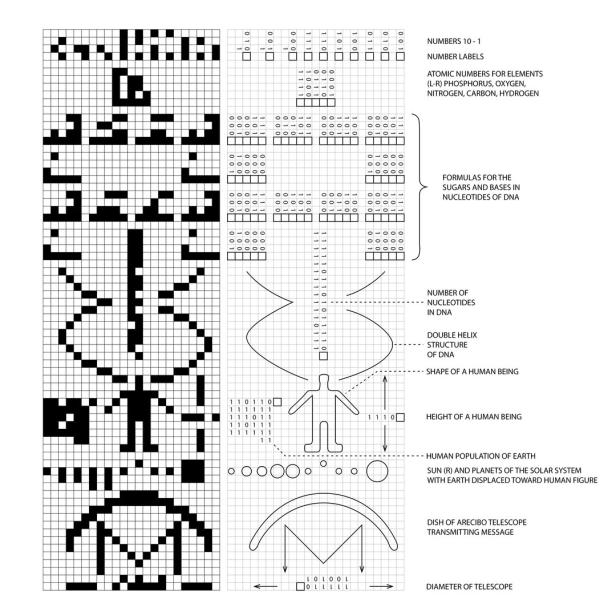It was a celebratory moment. Around 200 people gathered at the Arecibo Observatory in Puerto Rico on this November day. They wanted to witness a historic moment: the sending of the first message to aliens.
50 years ago, on November 16, 1974, the message rushed out into space, transmitted by a powerful radio transmitter that the telescope had. The message became famous as the “Arecibo Message” and contains information about us earthlings and our home planet – in case an alien civilization can receive it, decipher it and gain information from it.
The message consists of a binary code: a string of zeros and ones, 1,679 bits long, transmitted at 2,380 megahertz. It contains numbers, the most important atoms and building blocks of life, data about our genetic material DNA and its double helix structure, images of humans and information about our position in the solar system. This is what the iconic message looks like:

Arecibo message and decoded key
The author was the famous astronomer Frank Drake, who died two years ago at the age of 92. He had made drafts of such messages before and was interested in the question of how many extraterrestrial civilizations there might be. At the time he estimated the number at around 10,000.
Then why has there never been any contact? Because aliens, if they exist, are probably very, very far away and it is quite unlikely that everyone will have reached a similar level of technology at the same time that allows such messages to be sent, received and deciphered. With all his thoughts on the subject, Frank Drake is considered a pioneer of astrobiology, the study of extraterrestrial life.
A very long journey through space
Table of Contents
The Arecibo message had a clear goal: a star cluster called Messier 13 in the constellation Hercules. It’s no wonder that we don’t yet know whether someone out there has picked up the message and interpreted it correctly: Drake’s message has a delivery time of 25,000 years – even though it travels at the speed of light and therefore travels almost 300,000 kilometers per second.
But the distance is enormous, and by cosmic standards our letter has only just been sent. The radio signal has been traveling through the cosmos for 50 years and has traveled almost ten trillion kilometers during this time. When it arrives at Messier 13 in 24,950 years, it will encounter a world already changed: many of the thousands of stars will already be outside the signal’s route by then.
Even if one of the remaining stars where mail delivery is possible is inhabited by creatures that can do something with a radio signal, and even if they respond promptly, humanity will have to wait another 25,000 years for the response. Will there still be people at all then? And if so, at what technical standard?

Arecibo-Observatory
From this station in Puerto Rico, the message was sent into space using radio waves in 1974. The observatory is now out of use and partially destroyed.
This shows the fundamental dilemma of all attempts to talk to aliens: they are probably pretty darn far away, as Drake correctly noted decades ago. Today we know of thousands of exoplanets: planets in other solar systems that orbit around their star like the Earth orbits the sun, some of them in the so-called habitable zone, which – purely theoretically – could allow life according to the Earth’s pattern.
Some exoplanets are a few dozen light-years away, others thousands. A potential exchange of messages thus far exceeds all human time scales. In addition, despite the very high probability that we are not alone in the universe, there is still another problem. Let’s say one of our messages arrives on a particularly hot candidate for extraterrestrial life: But living does not mean that it is a similarly developed civilization. Perhaps there are living beings, but in the stage of bacteria, similar to the early days of the earth, which still have many stages of their evolution ahead of them.
It is also conceivable that civilizations existed that were significantly more developed than us humans, but had long since passed their peak or even become extinct before the news arrived.
It is therefore not particularly likely that two civilizations will exchange mutually understandable messages at exactly the right time in their development from the appropriate corners of the cosmos and over gigantic distances.
The fear of evil aliens
But should we even try to make contact? There are definitely opponents of interstellar communications. They think we could possibly attract evil aliens who will one day attack us. On the other hand: We are constantly sending light into space – so-called technosignatures that modern civilization constantly produces.
Conversely, attempts to capture messages from aliens have so far failed. The legendary SETI project, designed to detect signals from potential extraterrestrial intelligence, also just celebrated an anniversary: it was founded 40 years ago. In this case, too, the mailbox remained empty.
## Did We Just Send a Message in a Bottle to Space? 50 years of the Arecibo message
**World-Today-News Exclusive Interview**
Fifty years ago, humanity sent its greetings to the cosmos.The Arecibo Message, a carefully crafted binary code packed wiht information about Earth and its inhabitants, was beamed towards the star cluster Messier 13. while the odds of a response are astronomically slim, the message remains a testament to our enduring curiosity and desire to connect with life beyond our planet.
To mark this anniversary, we spoke with **Dr. Emily Carter**, a renowned astrophysicist and expert on SETI (Search for Extraterrestrial Intelligence), about the significance of the Arecibo Message, the challenges of interstellar communication, and the future of our search for extraterrestrial life.
**World-Today-News:** Dr. Carter, the Arecibo Message was a bold endeavor. What motivated the scientists behind it?
**Dr.Carter:** The Arecibo Message was born out of a profound desire to know if we are alone in the universe. Frank Drake, the driving force behind the project, was a pioneer in the field of astrobiology. He believed that the vastness of the cosmos implied the existence of other clever lifeforms, and he saw the Message as a frist step towards establishing contact.
**World-Today-News:** The message itself is fascinating, containing information about our DNA, our solar system, and even images of humans. Was this information chosen for any particular reason?
**Dr. Carter:** Absolutely. each element was meticulously selected to convey a basic understanding of who we are and where we come from. The message was designed to be universally understandable, regardless of the recipient’s technological advancement.
**World-Today-News:** Though, we haven’t received any response. How long will it take for the message to reach its destination?
**Dr.Carter:** The target, Messier 13, is about 25,000 light-years away. That means it will take 25,000 years for the message to arrive. And given that it took 50 years just to build the technology for transmission in the 1970s, expecting a reply within a human lifetime is highly unlikely.
**World-Today-News:** Does this mean the message was ultimately a futile gesture?
**Dr. Carter:** Not at all! The Arecibo Message serves a valuable purpose beyond the possibility of a response. It represents a milestone in our scientific and cultural history. It embodies our curiosity, our ingenuity, and our yearning for connection on a cosmic scale.
**World-Today-News:** Looking forward, how do you see the field of SETI evolving?
**Dr.carter:** While the Arecibo Message employed radio waves, future endeavors will likely explore a wider spectrum of communication methods.We may use lasers, neutrinos, or even theoretical concepts like quantum entanglement. As our understanding of the universe expands, so will our ability to seek out and potentially communicate with other civilizations.
**World-today-News:** Thank you for sharing your insights, Dr. Carter. Perhaps one day, that message in a bottle sent 50 years ago will reach its destination and lead to a truly remarkable discovery.


